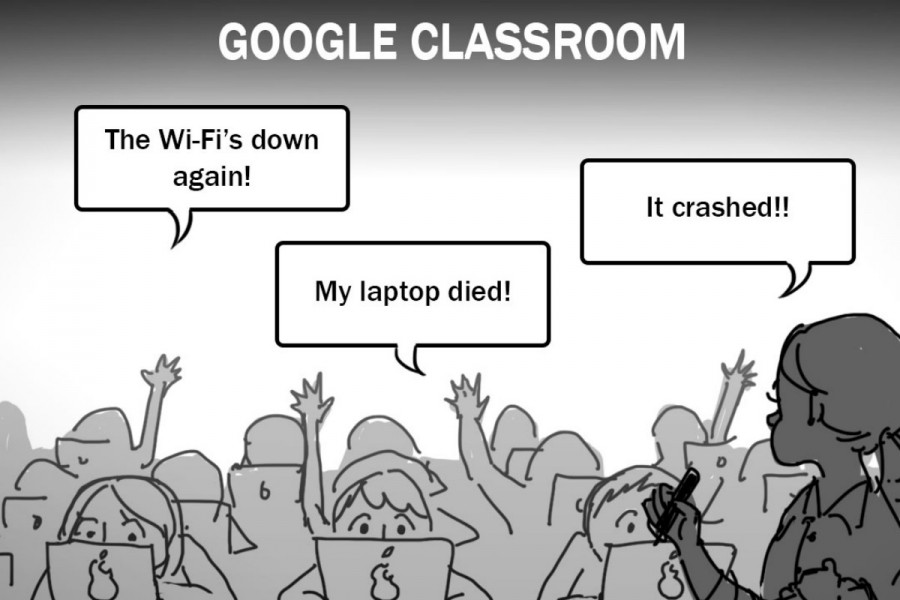The school implemented the program Google Apps For Education (GAFE) in August 2015 as part of the district’s digital movement, in addition to the Bring Your Own Device program initiated last school year, and many agree that the program has resulted in some benefits.
However, as the school transitions to a digital focus, the change yields negative consequences that should be resolved. This new classroom system is responsible for numerous disadvantages that should teachers should as soon as possible in order to reduce stress.
While the intention of the GAFE implementation is to reduce the stress students had in trying to locate class materials and assignments, it actually increases student stress in a variety of ways. Students have generally been expected to bring completed homework into class at the start of the period. However, Google Classroom allows digital due dates to be set at any point in time.
The school seems to have also recognized that Google Classroom has its flaws. Recently, Principal Wynne Satterwhite visited one of math teacher Judy Strauss’ classes, using the time to discuss the main elements of student stress. Satterwhite responded to the feedback regarding how Google Classroom enables teachers to set stressful deadlines, often at midnight.
“These crazy 11:59 p.m. deadlines,” Satterwhite said. “Aren’t we telling students to go to bed by then?”
Assignments can also have strict deadlines set at various points of time in class. Submitting work online even seconds after the assigned deadline is automatically labeled as late. These non-negotiable deadlines can seem unfair. The necessity to remember to not only complete, but also properly submit and turn in every assignment done online is overwhelming.
Staying organized is also made increasingly difficult by the various amounts of on and offline platforms teachers use. It is up to teacher discretion to take advantage of all the technology. Students must keep track of both classes entirely on the web and those sticking to traditional paper and pencils.
“I have teachers on different or multiple platforms,” junior Kelly Lambertson said. “It’s frustrating.”
Certain classes work online better than others do. Strauss does not currently use the Google Classroom system to assign and collect work.
“It’s… the way I have my class structured,” Strauss said. “There may be something that is brought up in class that is really interesting to pursue. I’d like to give students the opportunity and the time to explore.”
The advantage of working offline goes beyond the ease of showing work. A digital agenda with set times for each assignment discourages discussion and creativity because students may feel rushed. The screen is ultimately a barrier between a student and the teacher and classmates around them.
Human interaction is important for education, but the GAFE system threatens this. If teachers post or update assignments online outside of class, students must check their notifications whenever possible. Furthermore, students at home have limited ways of clarifying what directions they receive because they cannot ask questions in person.
While email may seem like an efficient alternative to talking in person, it would be inefficient to send a new email for every follow up question in order to clarify information. A flowing conversation is impossible this way, especially considering that responses are often delayed or sometimes never made.
“I can understand that teachers get a lot of emails,” junior Devika Kumar said. “I understand if they take some time to reply. [The problem] is more when they never respond.”
There are many potential solutions that can ease the problems with the GAFE system. Teachers could decide to replace midnight or other unfavorable deadlines with ones at the start of the next period, and they might consider being more lenient for assignments that are turned in online slightly late to reduce stress. Also, classroom discussion and collaboration offline should remain an important part of school.
Google Classroom has the potential to be a revolutionary step in our school’s technological advancement. However, it is crucial to consider the problems created as a result of Google Classroom’s implementation. Learning should not depend on the speed and accessibility of the internet and the reliability of our devices. Technology should be used to shorten the distance between students and their peers and teachers. The GAFE system is the rough draft of a vision only obtainable after several pressing revisions are made.



